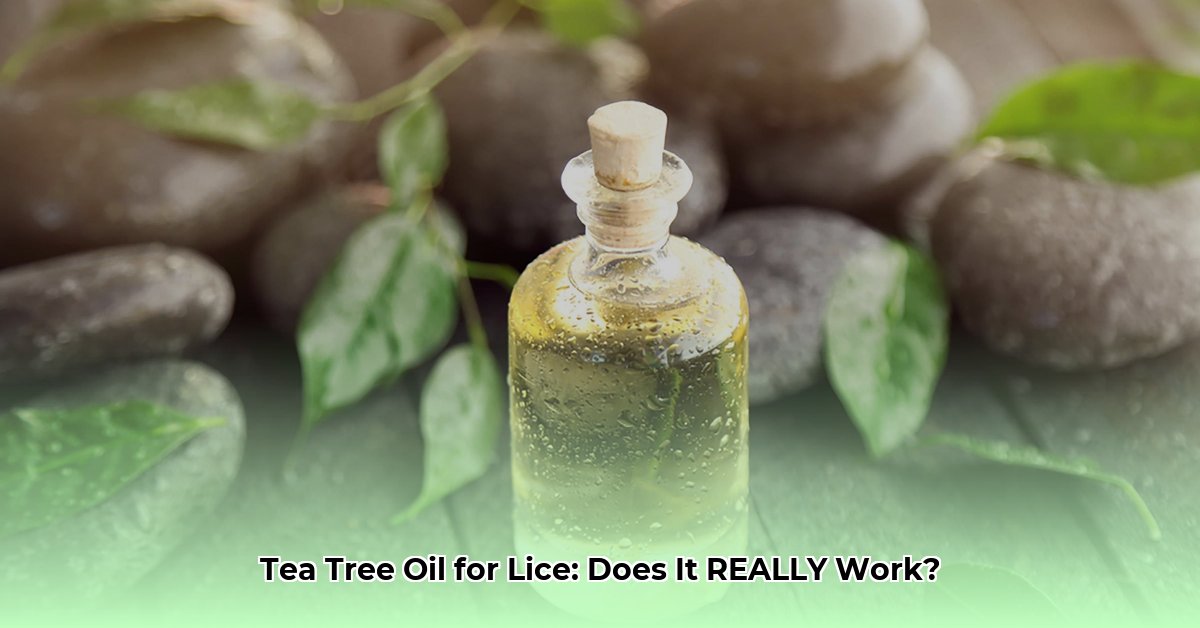Understanding Lice and the Allure of Natural Remedies
Head lice. Just the thought can make your scalp itch. It’s understandable why many people, especially parents, seek gentler, natural solutions like tea tree oil. But does it really work? Let’s explore the science behind tea tree oil and its potential role in treating head lice.
Tea tree oil contains terpinen-4-ol, a compound with insecticidal properties. This suggests it might combat lice and their eggs (nits). Some preliminary research even hints at tea tree oil having repellent properties. However, much of this research is in vitro (lab-based), not on actual infestations in people. So, while intriguing, these findings aren’t conclusive proof of real-world effectiveness.
Tea Tree Oil for Lice: Myth vs. Fact
Let’s debunk some common misconceptions:
| Myth | Fact |
|---|---|
| Tea tree oil is a guaranteed lice cure. | More research is needed to confirm its real-world effectiveness against head lice. |
| Tea tree oil is entirely safe for everyone. | It can cause skin irritation, allergic reactions, and even hormonal effects (rarely) in prepubescent boys. Careful use is essential. |
| All tea tree oil products are the same. | Concentrations and quality vary, impacting effectiveness and safety. Choose a reputable brand. Don’t assume all similar products work equally effectively |
Using Tea Tree Oil for Lice: A Cautious Approach
If considering tea tree oil for lice, consult a doctor, especially for children. Safety is paramount.
1. Dilute Properly: Never apply pure tea tree oil directly to the scalp. Dilute it with a carrier oil (coconut, olive, etc.). A 1% solution (1 part tea tree oil to 99 parts carrier oil) is a good starting point, but optimal concentrations are still being researched.
2. Apply to Hair and Scalp: Gently massage the diluted mixture into the scalp and hair, ensuring thorough coverage.
3. Wait Patiently: Leave the oil on for at least 30 minutes (or as directed by your doctor). Never exceed the recommended duration.
4. Comb Thoroughly: Use a fine-toothed nit comb to meticulously remove dead lice and nits. This is crucial, even if the oil kills some lice, to physically remove them.
5. Repeat Regularly: Repeat this process daily for several weeks. Consistency is key for any potential benefit.
Tea Tree Oil vs. Conventional Treatments
Conventional lice treatments have more robust scientific backing and established success rates. They’re the proven veterans, while tea tree oil is a promising rookie.
An Integrated Approach and Other Natural Remedies
Tea tree oil alone is unlikely to eradicate lice completely. Combine it with nit combing. Other natural remedies include neem oil, but further research is needed to validate their effectiveness and safety.
Remember, “natural” doesn’t equal “risk-free.” Consult a healthcare professional before using any new lice treatment, especially on children, pregnant or breastfeeding women. They can provide personalized guidance.
The Science Behind Tea Tree Oil and Lice: A Deeper Dive
Let’s explore the current scientific understanding of tea tree oil’s potential role in lice treatment.
Does It Really Work?
The evidence is mixed. Some studies suggest it might help, but it’s not a guaranteed solution. More research is needed to confirm its effectiveness.
How Could It Work?
Terpinen-4-ol, a compound in tea tree oil, is thought to disrupt the lice’s nervous system. But the exact mechanism isn’t fully understood.
What Does the Research Say?
A 2012 lab study found tea tree oil effective against lice and nits, but lab results don’t always translate to real-world success. Another study showed a tea tree oil and lavender oil mixture performed similarly to the chemical asphyxiant and even better than a pyrethrin/piperonyl butoxide treatment. These are positive signs, but larger, real-world studies are crucial.
Safety First
Tea tree oil can cause skin irritation or allergic reactions. Never ingest it—it’s toxic. Rare cases of breast growth in prepubescent boys have been linked to topical products containing tea tree and lavender oil. Consult a healthcare professional before using it, especially on children or sensitive skin.
Tea Tree Oil vs. Conventional Treatments
Conventional treatments are currently more reliable, with proven effectiveness and extensive testing.
Could It Prevent Lice?
Some research suggests a potential preventative effect, especially when combined with peppermint oil. Further research is needed to confirm this.
Ongoing Research
Research into tea tree oil and lice is ongoing. Scientists are exploring its mechanisms, ideal concentrations, application methods, and long-term safety.
Addressing Common Questions
- How long does it take to work? We don’t have a definitive answer yet. Studies use varying application times and concentrations.
- Is it safe for kids? Consult your pediatrician. They can advise based on your child’s health.
- What if it doesn’t work? Have a backup plan. Conventional treatments are generally more reliable.
Disclaimer: This information is for educational purposes and does not substitute professional medical advice. Consult a healthcare professional before using tea tree oil for lice, especially on children.
- Glass Lunch Box Containers Offer Healthy, Leak-Proof Meal Prep - December 21, 2025
- Glass Bento Boxes Offer a Healthy, Eco-Friendly Lunch Solution - December 20, 2025
- Glass Bento Containers Make Packing Lunch Easier and Healthier - December 19, 2025










